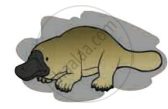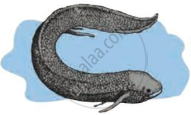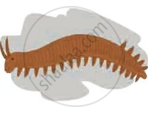Advertisements
Advertisements
प्रश्न
Write short notes based upon the information known to you.
Connecting link
उत्तर
Connecting link: Connecting link refers to plant and organisms which show characteristics related to two different groups. For example, Peripatus is considered a connecting link between annelida and arthropoda. It has characteristics like segmented body, thin cuticle and parapodia-like organs which are similar to annelids. It also shows tracheal respiration and open circulatory system which is similar to arthropods. Another example is duck billed platypus which is a connecting link between reptiles and mammals as it lays eggs like reptiles and has mammary glands like mammals.
APPEARS IN
संबंधित प्रश्न
What are vestigial organs?
Which of the following pairs of two vegetables represent the correct homologous structures?
(A) Sweet potato and potato
(B) Sweet potato and tomato
(C) Carrot and potato
(D) Radish and carrot
If you are asked to select a group of two vegetables, out of the following, having homologous structures which one would you select?
(a) Carrot and radish
(b) Potato and sweet potato
(c) Potato and tomato
(d) Lady finger and potato
Explain the terms analogous and homologous organs with examples.
Find out from newspapers and popular science articles any new fossil discoveries or controversies about evolution.
Enlist any four sequential evolutionary names of human ancestors.
Give the importance of fossil in support of organic evolution
What are homologous organs?
Name two animals having homologous organs and two having analogous organs. Name these organs.
The organs which perform similar functions but have different basic structure are called :
(a) asymmetric organs
(b) analogous organs
(c) homologous organs
(d) homophonic organs
Wing of an insect and forelimb of a bird are :
(a) analogous organs
(b) analeptic organs
(c) homologous
(d) homophobic organs
Some dinosaurs had feathers although they could not fly birds have feathers that help them to fly. In the context of evolution, this means that ______
There are five animals A, B, C, D and E. The animal A uses its modified forelimbs for flying. The animal B uses its forelimbs for running whereas the animal C uses its forelimbs for grasping. The animal D can live on land as well as in water and uses its forelimbs to prop up the front end of its body when at rest. The animal E which respires by using spiracles and tracheae uses wings for flying but its wings are analogous to the modified forelimbs of animal A.
(a) What could the animals A, B, C, D and E be?
(b) Why are the forelimbs of animals A, B, C, D called homologous organs?
(c) What does the existence of homologous organs in animals A, B, C and D tell us about their ancestors ?
(d) Why are the modified forelimbs of animal A and the wings of animal E called analogous organs?
(e) State whether animals A and E have a common ancestor or not.
X, Y, and Z are three animals. The animal X can fly but animal Y can only run on ground or walls. The forelimbs of animals X and Y have the same basic design but they are used for different purposes such as flying and running respectively. The animal Z became extinct an long time ago. The study of fossils of Z tells us that it had some features like those of X and some like those of Y. In fact, Z is said to form a connecting link in the evolutionary chain of X and Y.
(a) What could the animals X, Y and Z be?
(b) What name is given to the forelimbs like those of X and Y which have the same basic design but different functions?
(c) Name one feature in which Z resembled X.
(d) Name one feature in which Z resembled Y.
(e) Which is the correct evolutionary chain involving X, Y and Z : X → Z → Y or Y → Z → X?
Identify the following pairs as homologous and analogous organs:
(i) Sweet potato and potato
(ii) Eye of octopus and eye of mammals
(iii) Thorns of Bougainvillaea and tendrils of Cucurbits
(iv) Fore limbs of bat and whale
You have potato, carrot, radish, sweet potato, tomato and ginger bought from the market in your jute bag. Identify two vegetables to represent the correct homologous structures.
(A) Potato and tomato
(B) Carrot and tomato
(C) Potato and sweet potato
(D) Carrot and radish
Complete the following chart:

“Appearance of melanised moths post-industrialisation in England is a classic example of evolution by natural selection.” Explain.
With the help of diagrams, describe emasculation and bagging.
Choose the correct option of the following question:
Wings of Insect and Birds are examples of :
Find an odd one out.
Name the parts shown in the diagram.
Human jaw

Define the evidence of evolution shown in the figure.

What is carbon dating?
Write the answers to the questions by observing the figure below.
 |
 |
 |
| (a) | (b) | (c) |
- Write the name of the animal ‘(a)’ in the figure.
- Write the name of the animal ‘(b)’ in the figure.
- Write the name of the animal ‘(c)’ in the figure.
- Which evolutionary evidence is illustrated by this figure?
- Write the definition of that evidence for evolution.
Biogenetic law states that ______.
Homologous organs and vestigial organs are examples of ______ type of evidence in evolution.
Which of these is not a vestigial organ in human beings?
- Define vestigial organs.
- Write names of any two vestigial organs in the human body.
- Write name of those animals in which these vestigial organs are functional.
Evolution has exhibited a greater stability of molecular structure when compared with morphological structures. Comment on the statement and justify your opinion.
Cucurbits do not develop thick and woody stem as they are:
Tendons and ligaments are examples of ______.
Flippers of Penguins and Dolphins are examples of:
The study of fossil evidence of evolution is called ______
How do we compute the age of a fossil?
Give a scientific reason.
Morphological evidences suggest that dog, sheep and wolf have a common origin.
